This month’s blog post is by Hayley Bradley, a postgraduate alumnus of the University of Kent.
She is about to graduate with an MA in Roman History and Archaeology. During her studies she spent 3 months in Rome, where she developed an interest in the ancient architecture and monuments of the Imperial Forums. This blog arose out of a curiosity towards how ancient monuments and spaces were perceived, in both ancient and modern Rome.
Walking along the Via dei Fori Imperiali in Rome today, when the Altare della Patria appears on our left, the remains of Trajan’s Markets and Forum become visible on our right. Beyond that, an impressively tall, white marble structure rises up from the ground; this is Trajan’s Column.

Figure 1: Trajan’s Column as viewed from the North side. Image by the author.
Just over thirty-eight metres high, it is one of the many ancient monuments that stand in Rome’s urban centre, striking for both its size and the intricate carved frieze that spirals up its exterior. Consecrated in 113CE, the Column was erected alongside the rest of Trajan’s Markets and Forum.
It comprises of twenty-nine blocks of Luna marble, most likely positioned using complex systems of pulleys and scaffolding (National Geographic provides a basic visual reconstruction here.
What we regard as Trajan’s Column today is drastically different to that which was originally perceived in antiquity. Foremost, it was not designed to stand alone. As one element of Trajan’s Markets and Forum, the Column would have been flanked by the Latin and Greek libraries, the Ulpian Basilica, and the Temple of Trajan.
One definite aesthetic difference to the original appearance of Trajan’s Column is that the frieze would have been colourfully decorated in antiquity, regardless of whether it was Trajan or Hadrian that commissioned the frieze. This changes its regal white appearance to one that might have been a little too gaudy for the modern viewer’s taste (see here for an in-depth discussion of colour on ancient sculptures). Due to over two thousand years of weathering, these colours have unsurprisingly faded away. It has only been through recent research that traces of colour have been rediscovered on Trajan’s Column.
Through time, its appearance has continued to change within the transient environment of the city of Rome. Nominal graffiti has been added by those who worked on it for restorative or archaeological purposes in the nineteenth and early twentieth century. During the fifteenth century, a statue of St. Peter replaced the colossal statue of Trajan that originally stood atop the Column.

Figure 2: The statue of St. Peter on top of Trajan’s Column, viewed from the North West side. Image by the author.
Additionally, lichens and fungus spores that previously thrived in micro-fractures in the marble of the monument have receded due to high traffic pollution levels in the city. These used to give the Column a more noticeable yellowish hue. Now instead Trajan’s Column faces erosive carbonic pollution comparable to that which irrevocably damaged the Arch of Septimius Severus.
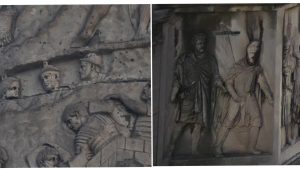
Figure 3: (left) Evidence of circular erosion where lichens and fungus spores once settled on the Column. (right) Pollution damage on the Arch of Septimius Severus. Images by the author.
So what was the ancient purpose of this monumental Column? And what is its purpose today?
Its frieze depicts the First and Second Dacian Wars in over two hundred metres of continuous pictorial narrative, built with the gold taken from Dacia during these conflicts. The Dacian spolia and the portrayal of Dacian barbarians on the Column verify that the narrative is focussed on the Dacian wars. Today, the images on the frieze are favourable for research into Roman military equipment and practice at that time.
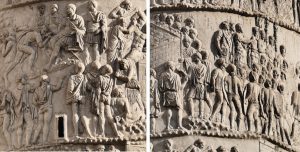
Figure 4: Depictions of Dacians on Trajan’s Column. Image by the author.
The Column was, and still is, an interactive monument. The spiralling frieze forces the onlooker into a pattern of anticlockwise circumambulation if they wish to attempt to read its narrative. This kind of experiential architecture is similar to that of Hadrian’s Mausoleum, and has an element of ritual meaning; Roman funerary monuments were typically designed to engage the viewer like this. In circling the monument, the onlooker subconsciously pays tribute to the late Trajan who is buried in the base. The Column immortalises him not only through its inscription and narrative frieze, but also through its very existence. Experiencing physical structures in ancient Rome was essential to Roman memory; by creating a monument, one would remind those passing of one’s life and achievements.

Figure 5: Hadrian’s Mausoleum, today more commonly known as Castel Sant’Angelo. Image by the author.
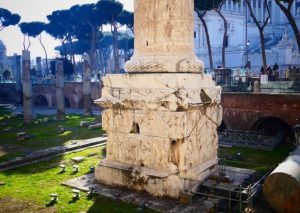
Figure 6: The pedestal of Trajan’s Column, viewed from the North East side. Image by the author.
In addition to the ritual purpose of the frieze, its narrative acts as promotion for the power of Trajan, offering us a romanticised historical account of the Dacian Wars. In particular, the size of the structure acts as a symbol of Trajan’s power and influence. Bystanders were expected to scrutinise the Column from close quarters, since the buildings surrounding it would have prevented a view from afar, like that which we have today. The restricted vertical perspective would have made the height of Trajan’s Column astonishing: a proposition of the supremacy that Trajan had as emperor. As a part of Trajan’s Forum and Markets, the Column acted as a reminder of how fruitful Trajan’s conquests had been, suggesting that his military action was worthwhile.
The version of Trajan that the Column commemorates is decisively idealised. The narrative focuses on his nobility as a leader, depicting ‘scenes of travel, construction, adlocutio, submission and sacrifice’ rather than the harsh realities of warfare. Trajan himself appears almost sixty times on the frieze, often overseeing military action rather than partaking, signifying his higher authority over his troops. His enlarged figure links him subliminally with the gods; often deities were portrayed as larger than mortals in ancient sculpture and artistry.

Figure 7: Trajan overseeing military activities in two different scenes. Images by the author.
Here, the monument also acts in a triumphal manner, suggesting that Trajan was worthy of deification due to his noble victories in war. The appearance of Victory with spolia at the end of the narrative on the First Dacian War, along with the spolia adorning the pedestal, support the idea that Trajan’s Column was, at least partially, a triumphal monument. This triumphal purpose of the monument can be attributed to Hadrian if he added the frieze, but, as discussed earlier, we do not have enough ancient evidence to know for certain.

Figure 8: the Dacian spolia on the pedestal of Trajan’s Column. Image by the author.
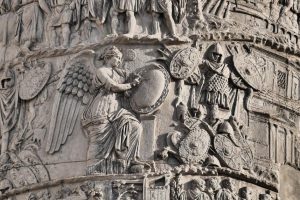
Figure 9: Victory with spolia on Trajan’s Column. Image by the author.
As both an honorific sepulchre and a political display of power and conquest, Trajan’s Column was so efficacious that Marcus Aurelius and Antoninus Pius both erected comparable dedicatory monuments. Marcus Aurelius’ even contains some identical narrative to that on Trajan’s Column, emphasising the powerful influence that ancient monuments could have.

Fig 10: The column of Marcus Aurelius. Image by the author. See here for contextualised images of Antoninus Pius’ Column.
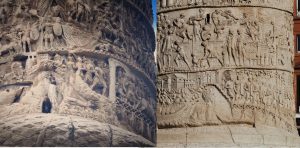
Fig 11: Two almost identical scenes involving the River Danube personified on the Column of Marcus Aurelius (left) and Trajan’s Column (right). Images by the author
Moving past Trajan’s Column today, one must consider how it contributes to the living history that exists in Rome. Many people have ambled by it, so that it has not only one, but multiple biographies that define it. The political and cultural observations made about Trajan’s Column will continue to change for locals, academics, and tourists alike. This temporal shift is ungovernable, and unavoidable. Yet when one is cognizant of the transient nature of the Column as a monument, then it is evident that its impact on the city of Rome will still be debated, reanalysed, and respected in years to come.
Further Information
On Roman history before Trajan see:
Smith, W. (1966). A smaller history of Rome from the earliest times to the death of Trajan. London: John Murray.
For an interactive look at the frieze see here. If you ever have the opportunity to visit Rome, le Domus Romane provides an excellent graphical reproduction of Trajan’s Column during their archaeological tour of a Roman villa. It discusses the narrative on the frieze while amplifying how intricate the artwork really was. Their website is here.
For those interested in the archaeology of the site, Packer (2001) provides a large, aerial view map of the archaeological site of Trajan’s Forum and Market, as well as several detailed reconstructions of the area.
Bibliography
Ancient Sources
Aurelius Victor, De Caesaribus, (tr.) H. W. Bird. Liverpool: Liverpool University Press, 1994.
Cassius Dio, Roman History, (tr.) H. B. Foster. Cambridge, MA: Harvard University Press, 2014.
Eutropius, breviarium ab urbe condita, (tr.) H. W. Bird. Liverpool: Liverpool University Press, 1993.
Modern Sources
Beckmann, M. (2002), ‘The Columnae Coc(h)lides of Trajan and Marcus Aurelius’, Phoenix 56:3, pp.348-357.
——(2011), The Column of Marcus Aurelius: the genesis and meaning of a Roman imperial monument. Chapel Hill: University of North Carolina Press.
——(2016), ‘Trajan’s Column and Mars Ultor’, Journal of Roman Studies 106, pp.124-146.
Bennet, J. (2001), Trajan: Optimus Princeps: a life and times. London; New York: Routledge.
Birley, A. R. and Tubb, J. N. (1999). Septimius Severus. London: Routledge.
Bradley, M. (2009), ‘The Importance of Colour on Ancient Marble Sculpture’, Art History 32:3, pp.427-457.
Calcini, G. and Abulkarim, M. (2003), ‘Apollodorus of Damascus and Trajan’s Column: From Tradition to Project’, Latomus 61, pp.666-695.
Claridge, A. (1993), ‘Hadrian’s Column of Trajan’, Journal of Roman Archaeology 6, pp.5-22.
——(2011), ‘Looking for Colour on Greek and Roman Sculpture’, Journal of Art Historiography 5, pp.1-6.
Coulston, J. C. (1988), Trajan’s Column: The Sculpting and Relief Content of a Roman Propaganda Monument. Newcastle: Newcastle University. PhD thesis.
——(1989), ‘The Value of Trajan’s Column as a Source for Military Equipment’ in van Driel-Murray (ed.) Roman Military Equipment: The Sources of Evidence. Proceedings of the Fifth Roman Military Conference BAR International Series 476, pp.31-44.
——(2016), ‘Trajan’s Column’ in S. Hornblower, A. Spawforth and E. Eidinow (eds.) Oxford Classical Dictionary. Oxford: Oxford University Press.
Davies, G. A. T. (1917), ‘Trajan’s First Dacian War’, The Journal of Roman Studies 7, pp.74-97.
Davies, P. J. E. (1997), ‘The Politics of Perpetuation: Trajan’s Column and the Art of Commemoration’, American Journal of Philology 101:1, pp.41-65.
——(2000), Death and the emperor: Roman imperial funerary monuments, from Augustus to Marcus Aurelius. Cambridge: Cambridge University Press.
Del Monte, M. (1991), ‘Trajan’s Column: Lichens don’t live here anymore’, Endeavour 15:2, pp.86-93.
——(1998), ‘Traces of Ancient Colour on Trajan’s Column’, Archaeometry 40:2, pp.403-412.
Dillon, S. and Welch, K. (2006), Representations of War in Ancient Rome. Cambridge: Cambridge University Press.
Frere, S. and Lepper, F. (1988), Trajan’s Column. Gloucester: Alan Sutton Publishing.
Hamburg, G. (1945), ‘The Columns of Trajan and Marcus Aurelius and their Narrative Treatment: the Epic-Documentary Tradition in the State Reliefs’ in G. Hamburg (ed.) Studies in Roman Imperial Art, with Special Reference to the State Reliefs of the Second Century. Copenhagen: Ejnar Munksgaard, pp.104-161.
Hölscher, T. (2004), The Language of Images in Roman Art. Trans. Snodgrass, A. and Künzl-Snodgrass, A. Cambridge: Cambridge University Press.
Hope, V. (1997), ‘Constructing Roman identity: Funerary monuments and social structure in the Roman world’, Mortality 2:2, pp.103-121.
Jockey, P. (2014), ‘The rediscovery of the gilding and the colours of Greek ancient sculpture’, Revue archéologique 2, pp.355-378.
Koeppel, G. M. (1980), ‘A Military Itinerarium on the Column of Trajan: Scene L’, Mitteilungen des Deutschen Archäologischen Instituts. Römische Abteilung 87, pp.301-306.
Lancaster, L. (1999), ‘Building Trajan’s Column’, American Journal of Archaeology 103:3, pp.419-439.
Meneghini, R. (1989), ‘Roma-Ricerche nel Foro di Traiano-Basilica Ulpia: un esempio di sopravvivenza di strutture antiche in età medievale’, Archeologia Medievale 16, pp.541-555.
Packer, J. E. (1993), ‘The West Library in the Forum of Trajan: The Architectural Problem and Some Solutions’, Studies in the History of Art 43, pp.420-444.
——(2001), The Forum of Trajan in Rome: a study of the monuments in brief. Berkeley, CA; London: University of California Press.
Poulter, A. G. (1992), ‘Trajan’s Column and the Dacian Wars’, Britannica 23, pp.331-333.
Rossi, L. (1971), Trajan’s column and the Dacian wars. Ithaca: Cornell University Press.
Schmitz, M. (2005), The Dacian Threat. Armidale, New South Wales: Caeros Publishing.
Stephenson, J. W. (2013), ‘The Column of Trajan in the light of ancient cartography and geography’, Journal of Historical Geography 40, pp.79-93.
Thill, E. W. (2011), ‘Depicting barbarism on fire: architectural destruction on the Columns of Trajan and Marcus Aurelius’, Journal of Roman Archaeology 24, pp.283-312.
Vogel, L. (1971), The Column of Antoninus Pius. Cambridge: Harvard University Press.
Wilson Jones, M. (1993), ‘One Hundred Feet and a Spiral Stair: Designing Trajan’s Column’, Journal of Roman Architecture 6, pp.23-38.
——(2003), ‘Trajan’s Column’ in M. Wilson Jones (ed.) Principles of Roman Architecture. New Haven: Yale University Press, pp.161-176.
Web Sites
Cartwright, M. (2013). The Arch of Constantine, Rome [Online]. Ancient History Encyclopaedia. Available from: http://www.ancient.eu/article/497/ [Accessed 20th February 2017].
——(2013). The Arch of Septimius Severus, Rome [Online]. ]. Ancient History Encyclopaedia. Available from: http://www.ancient.eu/article/502/ [Accessed 20th February 2017].
——(2013). The Arch of Titus, Rome [Online]. Ancient History Encyclopaedia. Available from: http://www.ancient.eu/article/499/ [Accessed 20th February 2017].
——(2014). The Column of Marcus Aurelius [Online]. Ancient History Encyclopaedia. Available from: http://www.ancient.eu/article/647/ [Accessed 20th February 2017].
History (n.d.). Deconstructing History: Colosseum [Online]. Available from: http://www.history.com/topics/ancient-history/colosseum [Accessed 18th February 2017].
Le Domus Romane di Palazzo Valentini (n.d.). [Online]. Available from: http://www.palazzovalentini.it/domus-romane/index-en.html [Accessed 18th February 2017].
Lucius’ Romans (n.d.). Ancient statues show their true colours [Online]. Available from: http://blogs.kent.ac.uk/lucius-romans/2016/10/15/ancient-statues-show-their-true-colours/ [Accessed 10th February 2017].
MacGregor, N. (2011). 2600 years of history in one object [Online]. TedGlobal. Available from: https://www.ted.com/talks/neil_macgregor_2600_years_of_history_in_one_object [Accessed 7th February 2017].
National Geographic (n.d.). How a Mysterious, Ancient Roman Monument Was Built [Online]. Available from: http://video.nationalgeographic.com/video/magazine/150315-ngm-building-trajans-column?source=relatedvideo [Accessed 10th February 2017].
——(n.d.). Reading an Ancient Comic Strip [Online]. http://www.nationalgeographic.com/trajan-column/index.html [Accessed on 20th February 2017].
Packer, J. (n.d.). The Theater of Pompey [Online]. The Pompey Project: King’s Visualisation Lab. Available from: http://pompey.cch.kcl.ac.uk/ [Accessed 20th February 2017].
Rome Reborn (n.d.). [Online]. Available from: http://romereborn.frischerconsulting.com/ge/TM-004-PA.html [Accessed 20th February 2017].
Sullivan, M. A. (n.d.) Base of the column of Antoninus Pius, Vatican Museum [Online]. Available from: http://www.bluffton.edu/homepages/facstaff/sullivanm/romanpius/romanpius.html [Accessed 24th February 2017].
The Life and Death of Via dei Fori Imperiali: 1932-2015 (2015). [Online]. Available from: http://romeonrome.com/2015/02/the-life-and-death-of-via-dei-fori-imperiali-1932-2015/ [Accessed 20th February 2017].
Understanding Italy (n.d.). Altare Della Patria [Online]. Available from: http://www.understandingitaly.com/lazio-content/altare-della-patria.html [Accessed 12th February 2017].
Wasson, D. L. (2013). Trajan [Online]. Ancient History Encyclopaedia. Available from: http://www.ancient.eu/trajan/ [Accessed 7th February 2017].